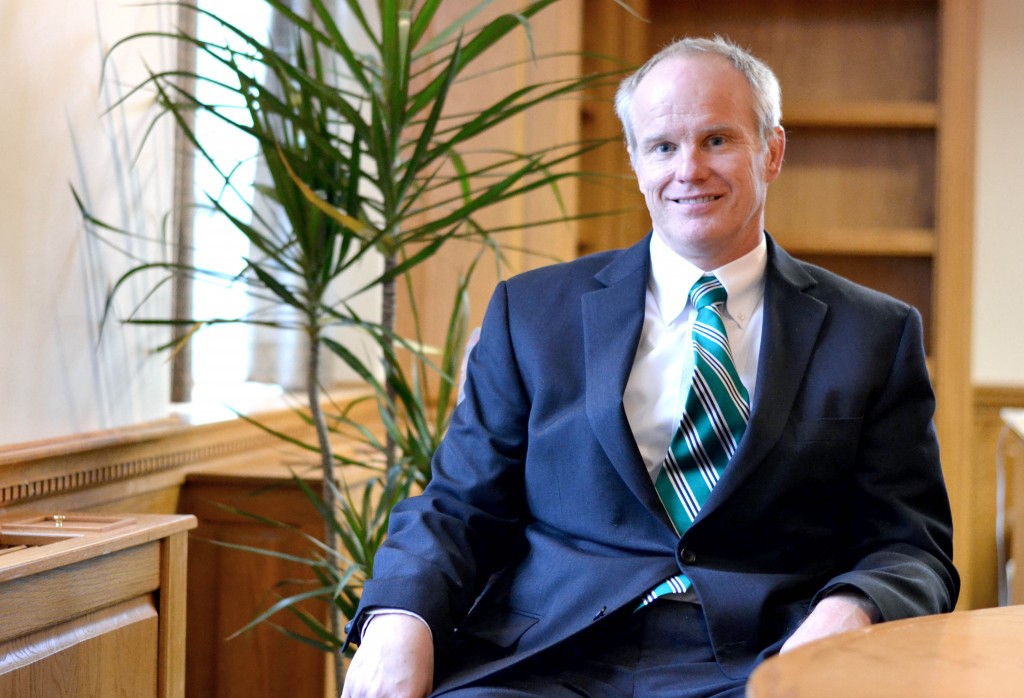
Binghamton University is now one step away from a $35 million grant in state funding, after University President Harvey Stenger made a comprehensive presentation to Gov. Andrew Cuomo and SUNY Chancellor Nancy Zimpher in Albany on Wednesday.
As part of the NYSUNY 2020 Challenge Grant program, BU will receive one-fourth of $140 million in capital funding, shared among SUNY’s University Centers in Binghamton, Albany, Buffalo and Stony Brook. The grants are aimed toward stimulating statewide job growth and changing the universities’ academic facilities and programs. Buffalo and Stony Brook have already had their plans approved.
The plan also allows the University to raise tuition.
In June, the New York State Legislature authorized SUNY schools to raise tuition $300 per year for in-state students through the 2015-16 academic year, $940 per year for out-of-state students at SUNY colleges and $1,340 per year for out-of-state students at the SUNY University Centers. Proponents describe the hikes as “rational tuition policy,” because planning the increases will allow students to prepare accordingly.
The construction of a $70 million Smart Energy Research and Development Facility is central facet of the University’s plan. The facility is intended to make Binghamton a center for research in various energy areas, including solar panels and phone batteries.
“The goal of the research is to develop new products, products as quickly as possible that we could then move to the market, either by ourselves through spinoff companies or with partnerships with local companies,” Stenger told Pipe Dream.
The plan also includes the increasing enrollment by 2,000 students and hiring 150 new faculty members and 175 professional staffers. Of the 2,000 students, 1,600 will be undergraduate students and 400 will be graduate students.
The student-to-faculty ratio is currently 21-1, and at the end of five years it will be 19-1, Stenger told Pipe Dream.
“The growth of 2,000 students is not something that’s contingent upon the program’s approval,” he said during a press conference. “That’s part of the plan that we think is a unique feature because the other University centers did not propose enrollment growth. But we felt with the strength of our applicant pool that we could grow our undergraduate population without sacrificing quality and students that are certainly capable of being great student.”
There is currently no timeline for when the proposal will be approved.
“I never want to predict timelines because as soon as I do I jinx it,” Stenger said to Pipe Dream. “So let’s hope we hear soon.”
While the administrators’ presentation focused on the plans to improve the BU institution, some students are expressing concern over the ways the University will rack in revenue.
“I’m opposed to SUNY 2020 in any form because it’s raising tuition, and people aren’t going to be able to pay once it rises,” said Tyler Albertario, a sophomore majoring in political science. “And I’m opposed to it because public education should be affordable for all. It should not be subject to the whims of a few who decided to raise tuition because they have this sort of privatization wet-dream for the future.”
Stenger has said that keeping BU affordable is a top priority. He said that $700,000 is currently set aside for need-based scholarships, and he plans to contact alumni to help increase this pool.
“It will be one of the most important responsibilities I have as president, to raise funds for scholarships,” Stenger said. “It will take several years, but the $700,000 to students who will not be able to pay that tuition increase next year is a good start.”
Brendan McQuade, business agent for the Graduate Student Employees Union (GSEU) and a graduate student in the sociology department, wrote in an email that the proposal is moving the University toward privatization. Instead of raising tuition, McQuade wants to see college offered at no cost.
“Instead of making universities compete to see which campus can best prostitute itself to the private sector, I think the state should fund SUNY fully and work toward the elimination of tuition,” he wrote.
State funding support for SUNY has declined by about $1.4 billion since the 2008-09 fiscal year, according to SUNY statistics, and is currently down to 21 percent of BU’s total budget.
McQuade wrote that partnering with the private sector will threaten the University’s ability to make autonomous decisions about producing “knowledge for the general welfare.”
“They produce knowledge for the instrumental purpose of generating private wealth,” McQuade wrote. “The real problem, then, is not with any particular challenge grant but with the whole scheme set up by NYSUNY 2020.”
While McQuade is skeptical of President Stenger’s proposal, he told Pipe Dream he admires the president’s commitment to the University.
“President Stenger is willing to work with students on pragmatic issues but, in his support for NYSUNY 2020, he stands for a policy project that hurts the interests of students who need public higher education the most,” he wrote.
Joe Garrant, a sophomore majoring in financial economics, said the proposal sounds like a positive step for the BU.
“I understand the crticism surrounding NYSUNY 2020, but the tuition increases are minimal compared to the benefits for the University,” Garrant said.
Gov. Cuomo optimistically concluded the presentation Wednesday by thanking Binghamton for the presentation.
“It’s fascinating to see,” Cuomo said at the conference. “It’s almost like seeing the progress of a child. You birth the piece of legislation and you work through it but then you see it in actual development and you see the energy that it’s creating in the local community. And that’s what it’s all about. The pieces are coming together.”
Stenger said he thought the pitch was successful.
“The presentation went very well,” Stenger told Pipe Dream. “We got no questions. We had compliments from everyone who was there. And now the governor is considering it. He’s going to get back to us with his decision.”
— Daniel S. Weintraub contributed to this report.


